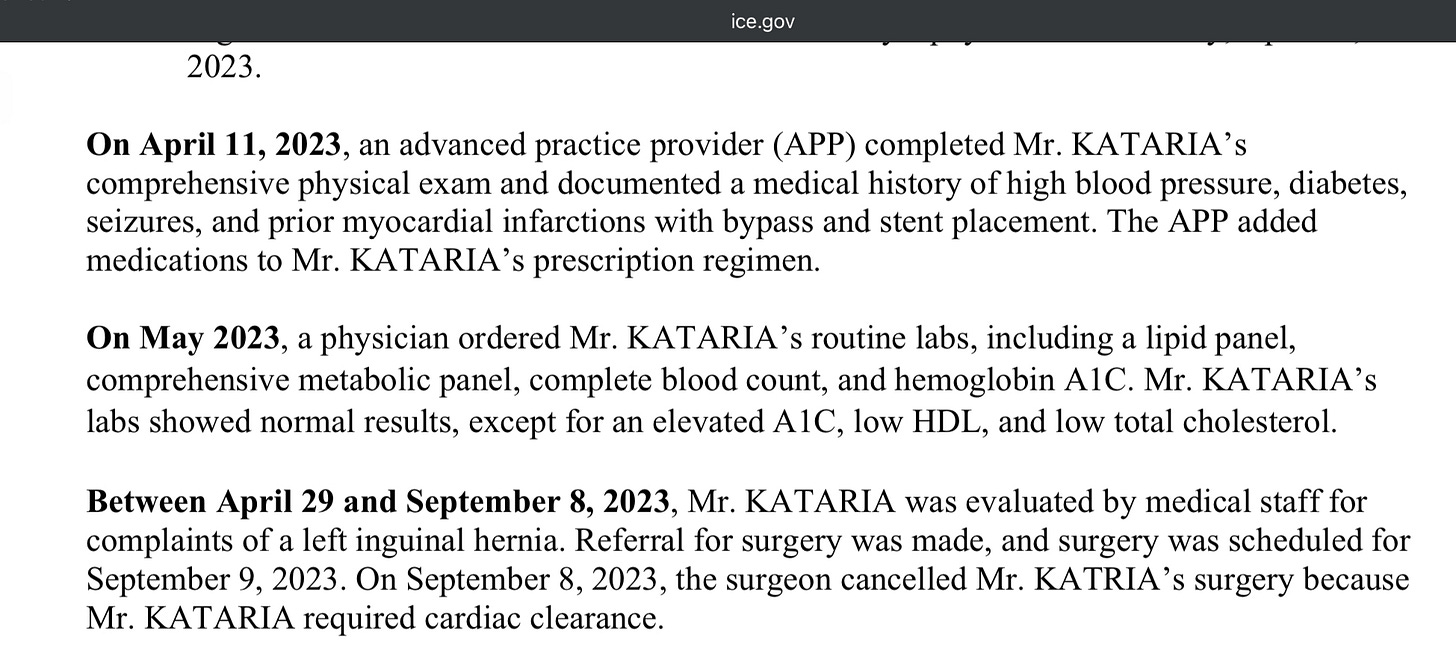The Death Machine Is Revving Up
With ‘opposition’ is so busy deciding who’s a ‘criminal’ subject to GITMO rendition, there’s been nary peep.
From Parole to Passing Away
As the U.S. reportedly reached a deal to take control of Ukraine’s natural resources in exchange for a ceasefire and the current president ends the temporary legal pathway his predecessor created or Ukrainians (and others), ICE announced the death of a Ukrainian national in its custody in South Florida yesterday.
44 year-old Maksym Chernyak, who was a beneficiary of the Biden-era parole program until his arrest for battery prompted an ICE detainer, arrest, and detention at Krome Service Processing Center on February 2. (Krome is one of the longest operating U.S. migrant torture prisons, as Prof. Brianna Nofil and I recently discussed).
He was rushed to the hospital on February 18 with seizures and vomiting. A CT scan apparently revealed a brain bleed. He was unresponsive upon arrival. He died February 24.
Physicians and forensic pathologists will need to opine on what might have happened to cause Chernyak’s symptoms. For now, I will simply offer that if this message finds his attorney, Colin Kaepernick’s foundation provides free, independent autopsies. Our project and others also have a host of resources for community responses to in-custody deaths.
Cherynak’s death is the third at Krome in as many months. 29 year-old Genry Ruiz-Guillen died January 23, 2025 after months of reports of dizziness. He was labeled psychotic and ultimately diagnosed as catatonic before his death, according to ICE’s initial death report. It will be for physicians and pathologists to assess whether the weeks of unattended complaints of vertigo and other symptoms in detention that seemed to prompt no further follow-up were indicative of a condition that might have been treatable had it been diagnosed promptly.
In December, 60 year-old Guyanese national Ramesh Amechand passed away following his imprisonment at Krome. He had a history of medical conditions so severe as to challenge any carceral medical system.
Because ICE claims he served 10 years for a child-sex offense, my bet is nobody was in a big hurry to elevate his case or seek his release. But civil migrant detention is not death row.
The same is likely true of 60 year-old Indian national Pankaj Katarina, who died on November 1, 2024, after having surgeries delayed while imprisoned for ICE at the Nye County, Utah jail before being flown to the deadly Prairieland Detention Center in Alvarado, Texas.
Readers of this publication will be all-too-familiar with the fates of Gourgen Mirimian and Maria Ochoa, among others who perished after ICE sent them there. Unsurprisingly, ICE actually IMPROVED PDC’s inspection rating following Kataria’s death, as I’ll cover in a forthcoming analysis of the OPR detention compliance inspections the agency has performed in FY25. Spoiler alert: things are getting much worse, per the agency’s own inspection teams).
If the government cannot keep people alive in the setting it chooses to detain them, it is incumbent upon the system to find another way to address its interests. Or, and I fear this will soon be far from a hypothetical scenario, the government should just admit that it will allow a certain number of disposable humans to suffer and die in order to fulfill its deportation objectives. Then we can move through the legal consequences of that acknowledgement and drop the pretense.
Ramping Up the Death Machine
The current state of mainstream discourse among opponents to the president’s deportation policies critique the present administration for not being as effective as the previous one, and for being too cruel to the wrong people.
(“His deportation numbers are lower than Biden’s.” + “He’s not even arresting criminals.” + “It’s all spectacle and bluster, and we (Democrats) were actually tougher.”)
In the realm of in-custody ICE detention deaths, however, this administration has already eclipsed its predecessor, and is on track to be substantially worse. Six have people perished this fiscal year—more than the total number of deaths in FY21, FY22, and FY23. And those are only the ones we know about.
These include a 45 year-old asylum-seeker from Ethiopia who, according to ICE’s dummy death report, seems to have been ignored by medical staff at Eloy on four different occasions prior to being hospitalized for and ultimately dying of lung disease on January 29, 2025.
It’s going to be much, much deadlier.
If you believe a person tortured to death at GITMO or dying on a plane is going to get a press release out of the present leadership of the agency, I am really curious to hear why.
The agency has already wiped its news releases page of deaths that occurred prior to February 2025:
I found this out by trying to determine where Jose Sanchez-Castro was detained after being arrested in Yakima, Washington, but before dying on October 27, 2024. Normally, I’d expect it to be the Northwest Detention Center in Tacoma. But that’s not provided in the dummy death report. Instead, we get only a vague reference to a “GEO” guard, which suggests is NWDC, but doesn’t rule out Mesa Verde.
Responding with Wisdom and Clarity
People dying inside these places need those of us who are not suffering as they are to care. That begins with deciding that no matter what crime an immigrant committed, no matter how many times they crossed the border, and no matter how personally distasteful we might find some of the decisions they made, unless and until they’re given the benefit of a death penalty trial (complete with counsel, jury, appeal, and all the rest), detention can’t be a death sentence. If it is, these are extrajudicial death camps. By the time the scale of mechanized death threatened by the current trajectory becomes enough for a critical mass of people to start raising objections, organizing, and resisting, my fear is that the criminalization and otherization the president’s political opponents are currently using to say he’s not “effective” will have been so normalized that there will be a totally disposable category of people who can simply be eliminated by the world’s largest, least accountable migrant caging system. Maybe we’re already there. Time will tell.
I do not find it adaptive or particularly wise to wait around and see. Communities of care and resistance can engage with people in detention while that’s still an option. That engagement, modeled by collectives affiliated with Detention Watch Network, means showing up and speaking out fearlessly and from a place of love and care, rather than political opportunism and ego.
We can slow down the death machine. We have done it before. We know how. It takes all of us. There’s a place for you, and a road to a more healthy future. But we have to make that road.
Until then, spare a thought for the communities who’ve lost loved ones in custody.








